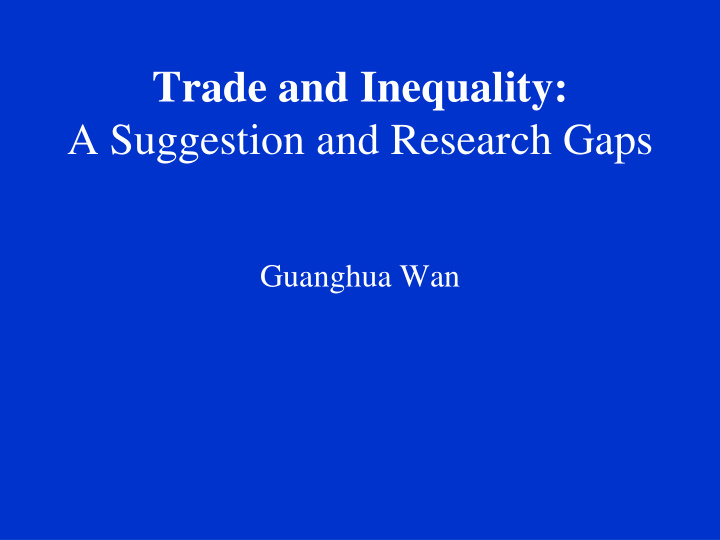



Trade and Inequality: A Suggestion and Research Gaps Guanghua Wan
Suggestion: Add “Poverty” into the “Trade-Inequality” discussion Poverty is an important issue in its own right. Much disquiet about globalization/trade originates from concerns about poverty and less about inequality. To some, inequality per se is not so important in the absence of absolute poverty. When the concept of relative poverty is used, inequality becomes synonymous with poverty. After all, why shall we worry about the trade impact on the non-poor/rich?
Trade-inequality Nexus: Empirical Issues Relatively little empirical evidence exists regarding the quantitative impacts of trade on inequality As far as the impact is concerned, no single theory can explain the diverse stylized facts It is subject to more empirical studies. Yet, empirical findings are mixed. Can we generalize?
Common Approach • Inequality = f (trade, Xs). • Choice of inequality index seems not important. • Choice of trade variable (openness, tariff rate…) and model specification are important. • Choice of study period and country/region are also important • Most important and yet an neglected issue : what aspect of the trade variable: – Mean of trade => inequality? – Dispersion of trade => inequality?
The Research Gaps • Assume: Income = a0 + a1 trade + a2 X • It is strictly true that: Ine(Income) = Ine (a0 + a1 trade + a2 X) • But the common approach uses: Ine(Income) = b0 + b1 trade + b2 X • Trade as a variable can be characterized by its mean and dispersion. It is the dispersion which is relevant in inequality analytics but is usually ignored except Wan (JCE, 2004; RDE 2006, and ROIW 2007). • The dispersion determines the sign and size of the contribution while the mean affects the size of the contribution
The Research Gaps • When trade is good for growth, it is inequality-increasing if the rich/poor trade more/less. Otherwise, it is inequality- decreasing • Gap 1: how to model both the mean (growing trade) and dispersion (trade convergence or divergence) impacts of trade on inequality and poverty ? • Gap 2: More empirical work needed before generalizing • Gap 3: Dynamic decomposition to examine changing role of trade in affecting inequality • Gap 4: It is important to distinguish “within vs between country inequality”, “spatial vs horizontal inequality”, “impact on developed vs developing economies”.
Global Inequality and Trade Upper-middle & high Low & lower-middle income countries income countries Variable Coefficient p-value Coefficient p-value Trade openness 0.0027 0.000 0.0021 0.033 FDI 0.0097 0.072 0.0109 0.095 Capital 0.0002 0.000 0.0008 0.002 2 (Capital) 0.0000 0.000 0.0000 0.131 Age dependency -1.1499 0.000 -0.6687 0.000 Inflation -0.0001 0.090 0.0000 0.775 Literacy -0.0030 0.152 -0.0005 0.801 Life expectancy 0.0018 0.677 0.0020 0.507 Real GDP 0.3440 0.010 0.7450 0.000 Freedom index 0.0243 0.483 -0.0136 0.421 Observations 485 340 F-statistic 477.820*** 373.430*** 2 Adjusted R 0.984 0.988 DWH-statistic 36.904*** 5.230* WH-statistic 17.625*** 3.127*
Inequality Decomposition Results Variables Gini Gini (%) GE 0 GE 0 (%) GE 1 GE 1 (%) 1990 Trade intensity 0.013 2.586 0.008 1.951 0.009 1.814 FDI 0.003 0.612 0.001 0.287 0.001 0.238 Capital 0.104 21.07 0.106 25.09 0.142 27.34 Age dependency 0.024 4.920 0.016 3.778 0.019 3.595 Inflation 0.000 0.000 0.000 -0.043 0.000 0.006 Literacy 0.002 0.349 0.001 0.322 0.001 0.284 Life expectancy 0.001 0.282 0.001 0.275 0.001 0.251 Real GDP 0.006 1.315 0.006 1.428 0.008 1.518 Freedom index 0.000 0.000 0.000 -0.189 -0.001 -0.196 Location 0.339 68.86 0.283 67.094 0.338 65.14 Total 0.492 100 0.422 100. 0.518 100 2004 Trade intensity 0.013 2.731 0.008 2.085 0.009 1.957 FDI 0.005 1.054 0.002 0.587 0.002 0.493 Capital 0.104 21.95 0.101 25.65 0.134 28.23 Age dependency 0.019 3.902 0.010 2.469 0.008 1.647 Inflation 0.000 0.000 0.000 0.000 0.000 0.001 Literacy 0.001 0.301 0.001 0.264 0.001 0.222 Life expectancy 0.001 0.280 0.001 0.293 0.001 0.261 Real GDP 0.010 2.095 0.003 0.772 0.003 0.619 Freedom index 0.000 0.016 -0.001 -0.173 -0.001 -0.196 Location 0.322 67.67 0.267 68.04 0.316 66.76 Total 0.476 100 0.392 100. 0.473 100
Regional Inequality in China: 1987- -2002 2002 Regional Inequality in China: 1987 0.14 0.139 0.127 0.123 0.12 0.117 0.117 China Urban 0.115 0.106 0.103 Rural 0.10 0.099 0.097 0.096 0.087 0.08 0.079 0.072 E0 0.065 0.063 0.06 0.04 0.02 0.00 1987 1989 1991 1993 1995 1997 1999 2001 2003 Year
16 Gov FDI Trade 14 12 % contribution 10 8 6 4 1986 1988 1990 1992 1994 1996 1998 2000 2002 Year
Table 2 Globalization and the income shares of the poor: bottom quintile Independent variable (1) (2) (3) (4) (5) (6) (7) (8) (9) (10) Globalization indicator: trade/GDP ratio Globalization g 0.029 0.011 0.030 0.032 0.028 0.029 0.030 0.025 0.040 0.045 0.001 0.301 0.021 0.052 0.035 0.028 0.028 0.057 0.007 0.003 Per capita income y -0.145 -0.300 -0.319 -0.319 -0.338 -0.354 -0.338 -0.309 -0.372 -0.381 0.000 0.000 0.000 0.000 0.000 0.000 0.000 0.000 0.000 0.000 Coast × g -0.004 0.843 Time × g -0.008 -0.010 -0.006 -0.008 -0.011 -0.012 0.054 0.026 0.155 0.058 0.009 0.008 Liberalization 0.046 0.063 0.113 0.038 Economic structure 0.056 0.096 0.122 0.015 Education -0.012 -0.011 0.460 0.510 Inflation -0.100 -0.134 0.016 0.002
Independent variable (1) (2) (3) (4) (5) (6) (7) (8) (9) (10) Globalization indicator: FDI stock /GDP ratio Globalization g 0.003 0.006 0.009 0.009 0.001 0.005 0.001 0.001 0.000 0.005 0.647 0.319 0.187 0.164 0.925 0.567 0.946 0.905 0.973 0.571 Per capita income y -0.115 -0.309 -0.329 -0.320 -0.325 -0.351 -0.325 -0.295 -0.346 -0.355 0.000 0.000 0.000 0.000 0.000 0.000 0.000 0.000 0.000 0.000 Coast × g -0.008 0.249 Time × g -0.009 -0.010 -0.009 -0.009 -0.012 -0.012 0.004 0.003 0.008 0.006 0.000 0.000 Liberalization 0.051 0.060 0.106 0.081 Economic structure 0.034 0.060 0.332 0.099 Education -0.013 -0.012 0.443 0.497 Inflation -0.081 -0.104 0.039 0.009
Recommend
More recommend